
Photographing Peru – Part 1 Lima to Cuzco
by Reinhard Thomas
January 17, 2017

Map of Peru in South America
Peru is a fascinating, culturally rich country with stunning man-made and natural attractions. From the High Andes Mountains with peaks of over 6700m to the jungle of the Amazon basin, deserts and over 3200km of Pacific coastline, Peru offers something to do and/or see for everybody.

Inca Terraces near Chivay
Our bus tour started in Lima, Peru’s capital city with a population of nearly 10 million inhabitants. We went along the Pacific coast to Arequipa, Cuzco and ended at Lake Titicaca. In this article I will talk about the first half of this journey from Lima to Cuzco.

Cuzco, the Jesuit Church of the Campania de Jesus in the center of Cuzco during the Corpus Christi Procession
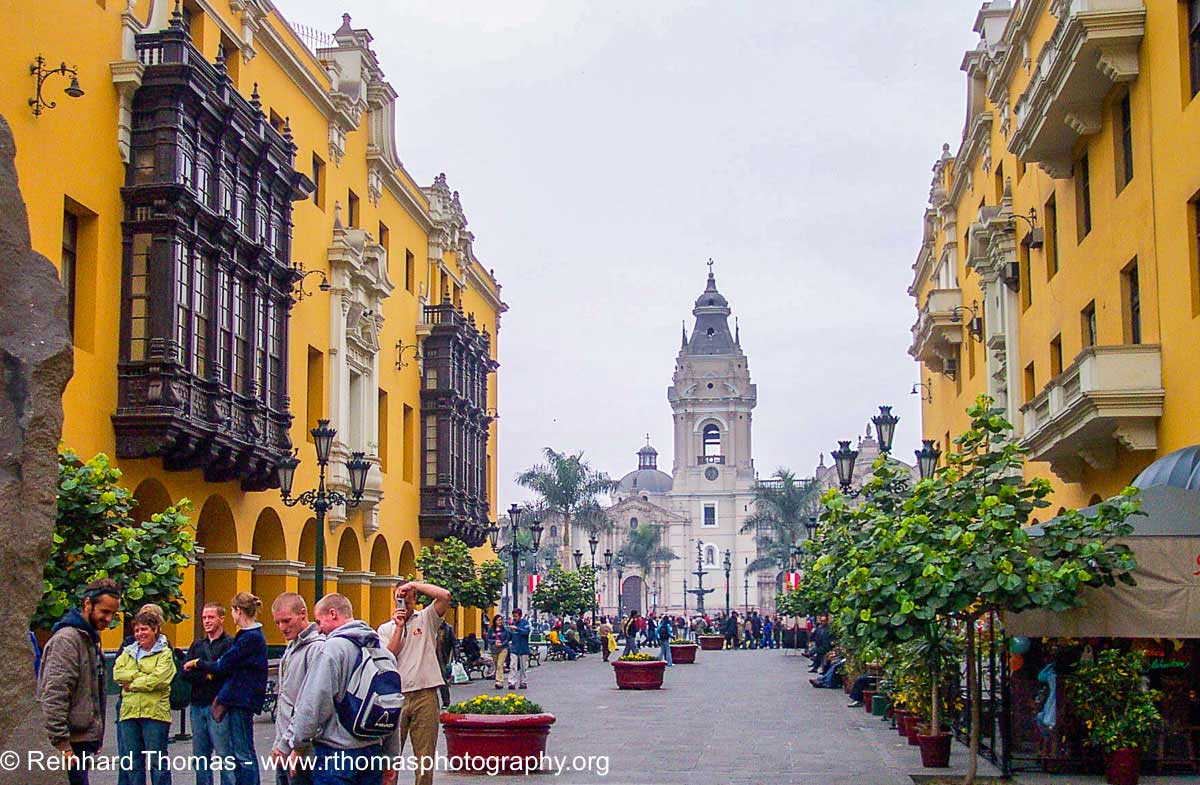
Lima view onto Plaza Mayor
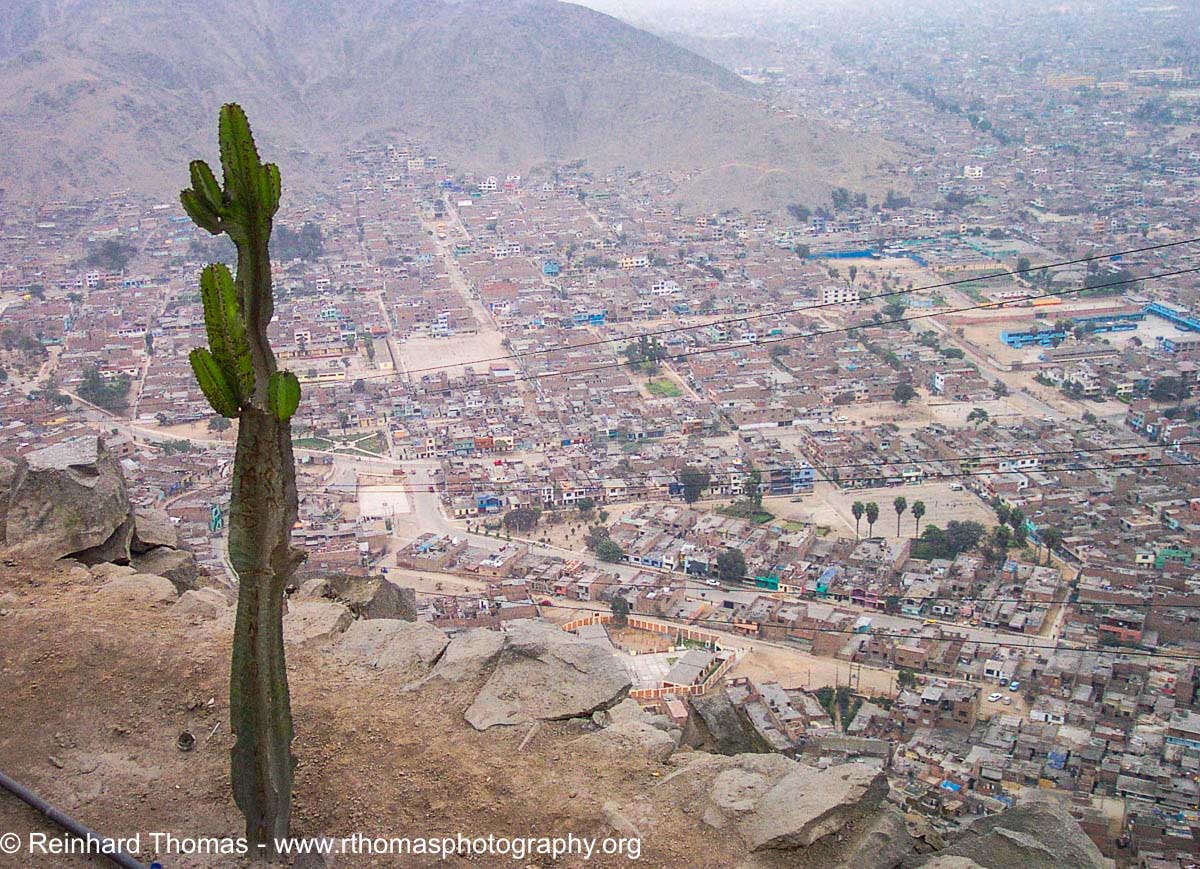
Outskirts of Lima
The Spanish Conquistador Francisco Pizarro founded Lima in 1535. The city was almost totally destroyed by a horrific earthquake in 1940 but most of the fine colonial buildings with their beautiful balconies were rebuilt. The city is home to some of the best museums in South America, and it is, like many big South American cities, a city of great contrast. From beautiful and rich districts in some parts of the city to slums, populated by Andean immigrants in the desert on the city outskirts. The Basilica Cathedral and the beautiful bronze fountain on the plaza in front of the Basilica are city highlights. The San Francisco Church and Convent with its great baroque style façade is one of the few buildings that withstood the numerous earthquakes since it was built in 1672. The church is home to a fine museum of religious art and you can descent down many levels, below the church into large catacombs filled with thousands of human remains and bones. The catacombs were dug in the 1550’s and were first used as a burial ground for priests and nuns and later for all religious citizens. As many as 75,000 bodies were interred here.

Some bodies were neatly placed inside the Catacombs under the San Francisco Church

Arequipa church with volcano in the background

Market in Arequipa
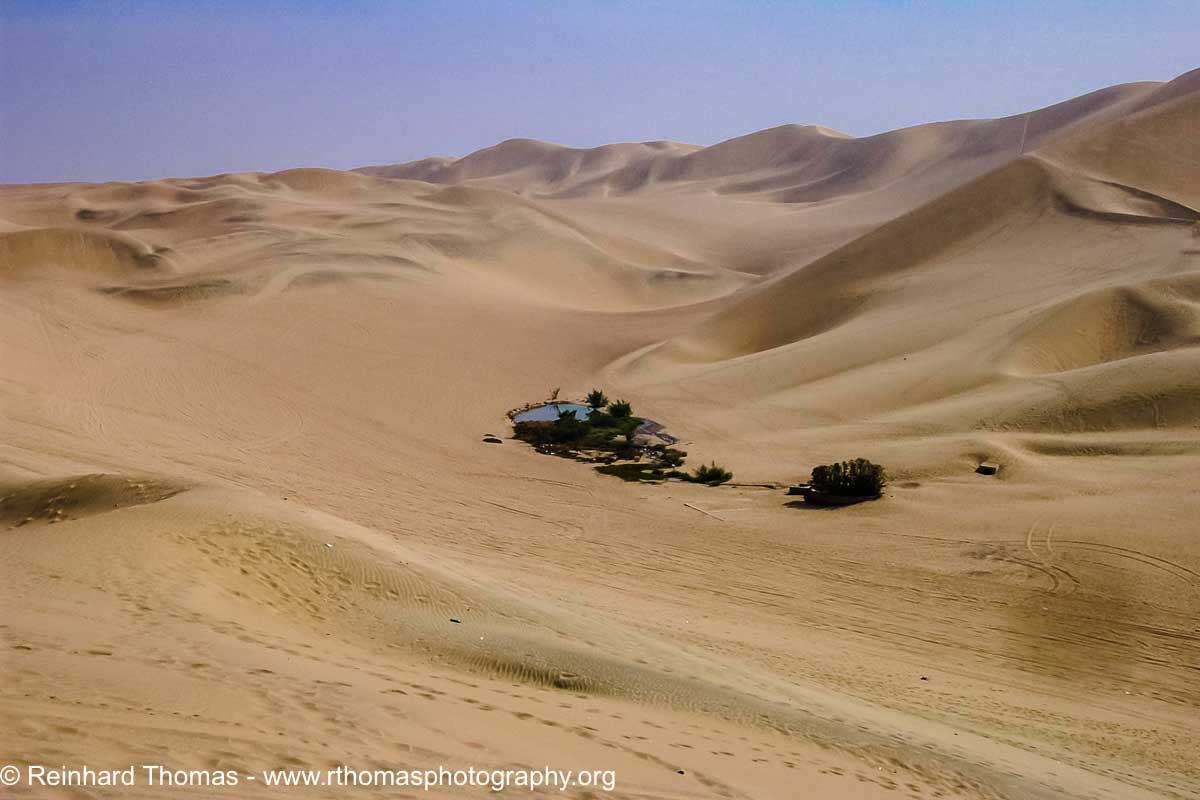
Oasis in the Desert
After spending a few days in Lima, we continue south along the Pacific coast to Pisco, the city after which Peru’s national drink, the “Pisco Sour”, is named (Pisco is a Peruvian liquor that is fermented from grapes. One could call it an un-aged brandy). The next morning finds us on a motorboat exploring the Ballestas Islands with their amazing rock formations and birdlife. The islands are home to over 150 bird species with millions of individual birds. Some of the birds you may see are cormorants, boobies and pelicans. Humboldt penguins and thousands of fur seals and sea lions call the islands home. The high concentration of birds results in the accumulation of large amounts of excrements that is harvested by the Government and sold worldwide as guano, a valuable fertilizer. One of the islands is home to a 200m high Candelabra permanently embossed into a mountainside. Some people believe that this mysterious figure is linked to the nearby Nazca lines and some speculate that pirates or sailors created it as a reference point.

Birds around Ballestas Islands.

Guano loading faciliy at Ballesas Islands.
Next we arrive in the oasis town of Nazca. We board a small, single engine plane and fly over the strange lines and figures that are etched into the desert floor. There are over 70 animals such as fish, birds, monkeys and owls depicted and some are up to 370m long. There are also several geometric shapes. Carbon test have revealed that these lines were created between 800BC and 300AD. Their meaning, source and purpose remains unknown and guesses range from extra-terrestrial creators to religious symbols or even a large astrological calendar. The truth is still unknown, making it a truly unique and imaginative experience.

Candelbrum at Ballestus Islands
A short trip deep into the desert brings us to the Chauchilla Cemetery. Here you can have a close-up view of ancient mummies, preserved by the extremely dry desert climate; some still have skin and hair intact.
-cemetary-.jpg)
Ancient mummies at the Chauchilla (Nazca) cemetary
On our way to Arequipa we stayed overnight in Puerto Inca, the old Inca port from which a series of runners took fresh fish to the Inca Emperor in Cuzco.
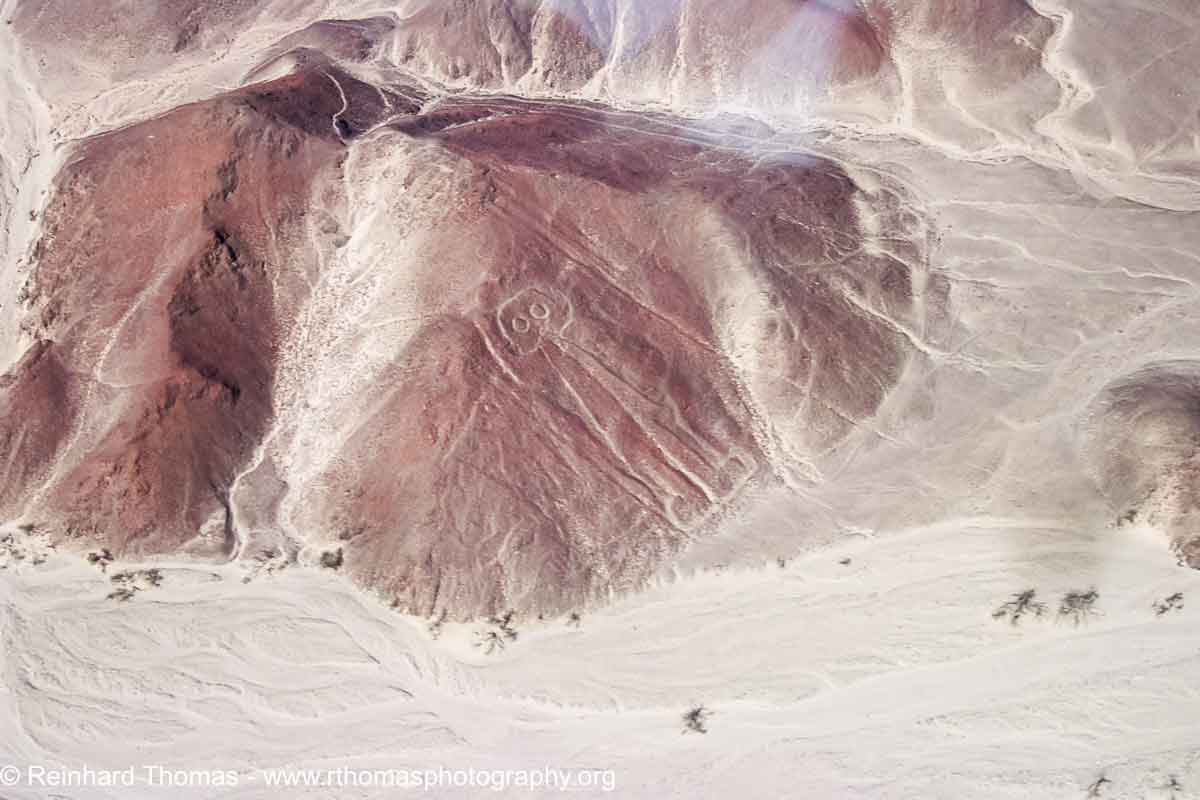
Nazca Lines, man with owl head, as seen from an airplane.
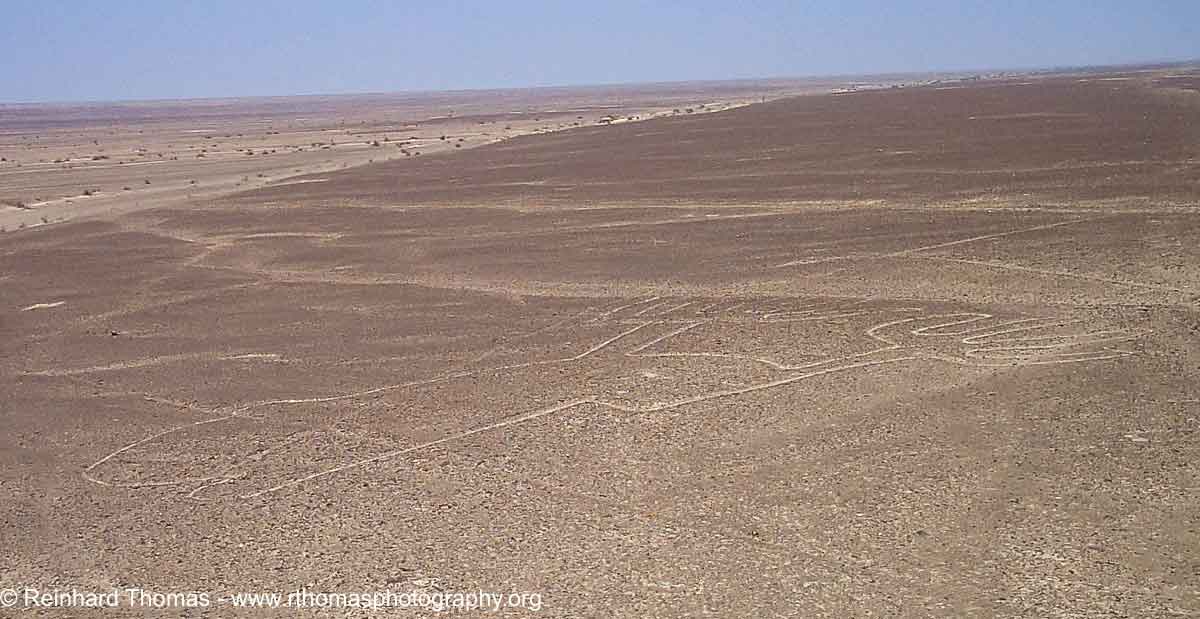
Nazcar line figure
After leaving the desert we arrive in the foothills of the Andes and make our home in Arequipa. This beautiful city is located at the foot of the El Misti Volcano at an elevation of 2380m above sea level. The city has a large cathedral and convent. The Santa Catalina Convent is almost a city in itself. This complex, which has cloisters and artfully decorated buildings located along a maze of cobbled streets has a fascinating history and was only opened to the public in 1970. The Museo Santuarios de Altura displays Juanita, the well known “ice mummy”. The 12 year old girl was sacrificed to please the Inca Gods on top of the 20,700ft tall Mont Ampatu around 1440 and remained there encapsulated in ice until she was found in the 1990’s.

Left: Indigenous family selling their hand crafts at the road side to Colca Canyon. Right: Indigenous women with lamas and donkeys.
Our journey continues to the Colca Canyon through a barren landscape and ghost towns, which were destroyed by past earthquakes. Colca Canyon is the world’s deepest canyon and from a viewpoint you can see the river flowing 1400m below you. In some places the canyon is almost 4000m deep, more than twice as deep as the Grand Canyon. If you are lucky you will see condors soaring on the hot thermal currents over the canyon.
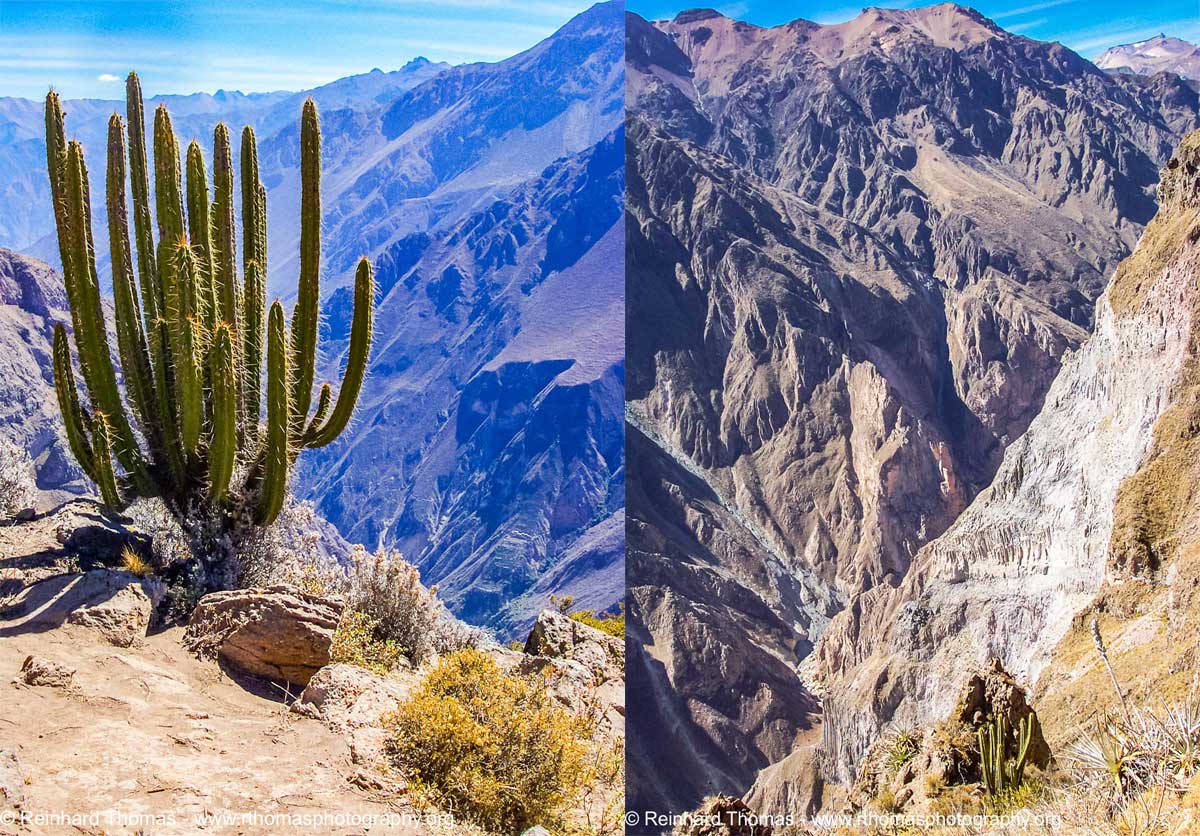
Left: The 100 km long Colca Canyon. Right View into the Colca Canyon.
On the way to the former Inca capital of Cuzco we pass through spectacular scenery dotted with Inca terraces.
Cuzco, at an elevation of about 3200m, was once the capital of the largest and most powerful State in South America, the Inca Empire. The center of Cuzco, or “navel of the world” in the Inca language, was formed around the Square of Weeping and the Square of Joy with Inca palaces built around these squares. Arcades with restaurants and stores line the Plaza de Armas in the city center. On a hill, outside of the city is Sacsayhuaman where you will find the most spectacular Inca walls with massive stones weighing up to 130 tons each.

View onto Cuzco from Sacsayhuaman

My wife and I at an Incal wall in Sacsayhuaman

Sand boarding in the Desert
Cuzco will be our base for excursions in the region, including the Sacred Valley and Inca Trail, which I will introduce you to in my next article. Note: All pictures were taken with a Kodak DX3900 camera with zoom lens.
Authors Biography & Contact Information

Reinhard Thomas is a photographer living in Calgary. He specializes in travel photography. Between travels he creates animal and landscape images and has a comprehensive collection of barn and grain elevator pictures.
Previous articles by Reinhard Thomas
Photographing around Devil's Island
Photographing Brazil’s Pantanal the Unknown Gem
Photographing in the Western Prairies
Photographing Madagascar
Photographing Cambodia, Kingdom of Wonder
Photographing the Spice Island of Zanzibar
Email: thomasrdu@telus.net
Web site: www.rthomasphotography.org
Phone: 403-239-3278
Click on the buttons below and share this site with your friends